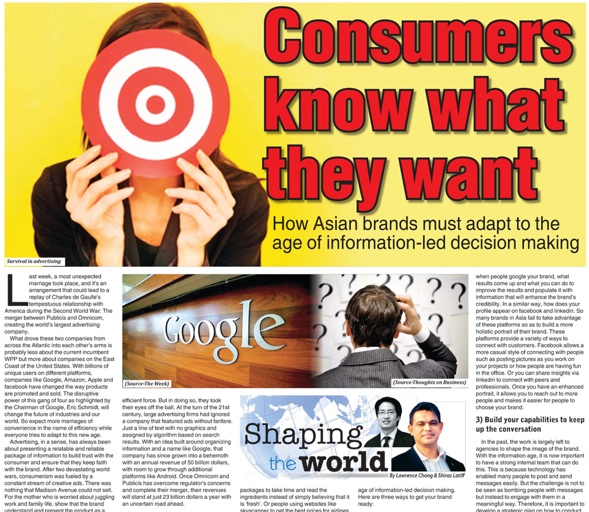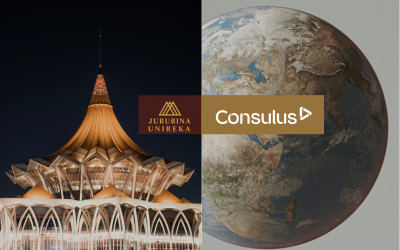Last week, a most unexpected marriage took place, and it’s an arrangement that could lead to a replay of Charles de Gaulle’s tempestuous relationship with America during the Second World War: The merger between Publicis and Omnicom, creating the world’s largest advertising company. What drove these two companies from across the Atlantic into each other’s arms is probably less about the current incumbent WPP but more about companies on the east coast of the United States. With billions of unique users on different platforms, companies like Google, Amazon, Apple and Facebook have changed the way products are promoted and sold. The disruptive power of this gang of four as highlighted by the Chairman of Google, Eric Schmidt, will change the future of industries and our world. So expect more marriages of convenience in the name of efficiency while everyone tries to adapt to this new age.
Advertising, in a sense, has always been about presenting a relatable and reliable package of information to build trust with the consumer and ensure that they keep faith with the brand. After two devastating world wars, a constant stream of creative ads has fueled consumerism. There was nothing that Madison Avenue could not sell. For the mother who is worried about juggling work and family life, show that the brand understands and presents the product as a sign of relief, then throw in jingle or two to seal the deal. For the young man seeking opportunity, present a future of possibilities. Supported by one-way mediums like television, radio and outdoor display, no one could question the messages and the people kept faith, till now.
The Dawn of information-led decision making
The scene opens with a man sketching the portrait of a woman as strangers describe her features. He then goes on to sketch another portrait and this time, based on the description given by the woman herself. When the two portraits are placed side by side, the results were startling as the ones described by strangers were far more beautiful. Dove’s “Real Beauty Sketches” is Madison Avenue at its best, and was supposed to add a ring of positive aura for the brand by suggesting that women are more beautiful than they think they are. But instead, it ignited a firestorm on the internet about the choice of the women featured, or how hypocritical it was for the owner of Dove, Unilever, who has another brand named Axe, known for its super-sexist ads. Welcome to this new age of information-led decision making, it is a two-way conversation and it is multi-channel. In the past, you needed an ad to frame the conversation but now, that need has been severely reduced by the amount of information available to the consumer. So the tables have turned, the brands have lesser power in telling consumers what to believe in. With access to information instantaneously, consumers are ignoring whatever emotional tricks we are throwing at them and are able to investigate and make informed decisions.
In a recent article written for the Financial Times, Jerry Femina, one of the icons of the advertising age, argued that the merger of Publicis and Omnicom may herald the next golden age for advertising if they succeed in marrying creativity with efficiency. Jerry probably forgot that this was the same pitch put forth by financial wizards like Martin Sorrell when they went round the world consolidating the ad industry through acquisitions. For almost two decades, titans like WPP, Publicis and Omnicom fought each other to acquire prized agencies, seeking to achieve unimaginable scale by acquiring creativity and turning it into an efficient force. But in doing so, they took their eyes off the ball. At the turn of the 21st century, large advertising firms had ignored a company that featured ads without fanfare. Just a line of text with no graphics and assigned by algorithm based on search results. With an idea built around organising information and a name like Google, that company has since grown into a behemoth with an annual revenue of 50 billion dollars, with room to grow through additional platforms like Android. Once Omnicom and Publicis has overcome regulators concerns and complete their merger, their revenues will stand at just 23 billion dollars a year with an uncertain road ahead.
New approaches are needed for the information age
For advertising to survive and for all brands to thrive in the new age, we must accept that the nature and process of persuasion has changed. We are now in the information age and how any data is presented, in terms of how it is perceived to be reliable will make a critical difference. This is a time where the packaging, if it is too perfect can come across as unreliable and untrue. We are now very familiar with the sight of people who are picking up the packages to take time and read the ingredients instead of simply believing that it is ‘fresh’. Or people using websites like Skyscanner to get the best prices for airlines or hotels ignoring the influence of marketing campaigns and ads. Increasingly, products will be differentiated by the quality of information instead of packaging design. People are already changing their buying habits through apps on smartphones. Very soon, you will be able to take a picture of the various products on the shelves and then receive feedback which will be re-organised in terms of information that correspond to your needs and health requirements.
For emerging Asian brands, this is a wonderful opportunity to skip the old models of persuasion and move into the modern age of information-led decision making. Here are 3 ways to get your brand ready:
1) Brands now know what consumers want too
With multiple platforms, it is now easier to build up fairly accurate profiles of your target customers. The challenge for many Asian firms is that they lack sufficient talent within to constantly study and review the data that they are receiving. The new change is not to rely so much on external resources but to build up internal capacity to speed up decision making and take action. During the last presidential elections in the US, the Obama campaign proved just how effective it can be when you work hard to identify profiles, assess the reactions and then customize the delivery of messages to each target group. These efforts were more effective than Mitt Romney’s campaign of focusing on messages alone with a major play on advertising. Right till the end, Obama’s campaign never took anything for granted by focusing on the data that they were receiving and customizing the messages. On election day, Obama’s campaign proved the pollsters wrong by cruising to victory with a comfortable margin in both the electoral college and the popular vote.
2) Enhance your online portrait with different facets of information
In this new era, it helps to add in different aspects of information to aid in decision making. It is critical to review what happens when people google your brand, what results come up and what you can do to improve the results and populate it with information that will enhance the brand’s credibility. In a similar way, how does your profile appear on Facebook and LinkedIn. So many brands in Asia fail to take advantage of these platforms so as to build a more holistic portrait of their brand. These platforms provide a variety of ways to connect with customers. Facebook allows a more casual style of connecting with people such as posting pictures as you work on your projects or how people are having fun in the office. Or you can share insights via LinkedIn to connect with peers and professionals. Once you have an enhanced portrait, it allows you to reach out to more people and makes it easier for people to choose your brand.
3) Build your capabilities to keep up the conversation
In the past, the work is largely left to agencies to shape the image of the brand. With the information age, it is now important to have a strong internal team that can do this. This is because technology has enabled many people to post and send messages easily. But the challenge is not to be seen as bombing people with messages but instead to engage with them in a meaningful way. Therefore it is important to develop a strategic plan on how to conduct brand engagement and state the desired outcomes. 50% of the work will have to be done in-house so that the brand can respond quickly. The other 50% can be done in partnership with a creative firm who can be retained on a long-term basis. The strategic plan must also detail the way information is to be collected and how they are to be processed. When we build these processes for clients, we often find that when the process is unclear then whatever insights that are gathered will be useless. The technology of interacting with customers continues to evolve rapidly. Google has just rolled out Google Glass which streams information to the viewer constantly. It seems utopian and no one is really sure what it can be used for. But everyone should keep an open mind because once people figure it out, another disruption could be on the way. Best to stay vigilant.
Lawrence Chong is the CEO of Consulus, a company specialising in helping Asian firms rebrand and redesign their organizations to be more innovative through business design. Consulus has begun operations in Sri Lanka in partnership with Hummingbird International. Shiraz Latiff is the CEO/Lead Consultant of Hummingbird International, a regional knowledge house specialising in coaching, consulting & outsourcing through global partnerships & collaborations.
This article is part of a weekly column called Shaping the World where Lawrence and Shiraz share insights and ideas about building innovative Asian Brands. It is published by one of the leading dailies in Sri Lanka, Ceylon Today.




